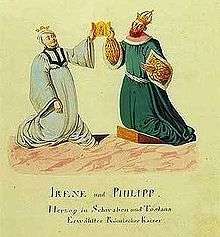Irene Angelina
| Irene Angelina | |
|---|---|
 Irene and Philip, after a 16th-century mural painting in the Lorch Abbey Church | |
| Queen consort of Sicily | |
| Reign | 1193 |
| Queen consort of the Germans | |
| Reign | 1198–1208 |
| Born |
c. 1181 Constantinople, Byzantine Empire |
| Died |
27 August 1208 (aged 26–27) Hohenstaufen Castle, Holy Roman Empire |
| Burial | Lorch Abbey |
| Spouse |
Roger III, King of Sicily Philip, King of Germany |
| Issue |
Beatrix, Holy Roman Empress Maria, Hereditary Princess of Brabant Kunigunde, Queen of Bohemia Elisabeth, Queen of Castile |
| House | Angelos |
| Father | Isaac II Angelos |
Irene Angelina (c. 1181 – 27 August 1208), was a Byzantine princess member of the Angelos dynasty and by her two marriages Queen of Sicily in 1193 and Queen of Germany from 1198 to 1208.
She was the second daughter of Byzantine emperor Isaac II Angelos and his first wife, an unknown Palaiologina? who became nun with the name Irene.
Marriage and issue
Irene was born in Constantinople, her father Isaac II inaugurated his reign with a decisive victory over the Norman invaders on the Balkans in the 1185 Battle of Demetritzes. In 1193 he and King Tancred of Sicily arranged Irene's marriage with Tancred's eldest son, Roger. Roger was declared co-king, but died on 24 December 1193, shortly before his father's death on 20 February 1194. Sicily was claimed by Tancred's aunt Constance and her husband, Emperor Henry VI. After he had conquered the Sicilian kingdom, Irene was captured on 29 December 1194 and was married on 25 May 1197 to Henry's younger brother, Duke Philip of Swabia. In Germany, she was renamed Maria.
After the Emperor had died on September 28, Philip was elected King of the Romans in Mühlhausen on 8 March 1198. Queen Irene's father, who had been deposed in 1195, urged her to get Philip's support for his reinstatement; her brother, Alexius, subsequently spent some time at Philip's court during the preparations for the Fourth Crusade. She thus had an early influence on the eventual diversion of the Crusade to Constantinople in 1204. Rivalled by the Welf scion Otto IV, Philip was able to stable his rule over the German kingdom. On 21 June 1208, he was killed by the Bavarian Count Palatine Otto VIII of Wittelsbach, leaving Irene widowed a second time.
Philip and Irene had seven children, two sons (Reinald and Frederick) who died in infancy and four daughters:
- Beatrix (April/June 1198 – 11 August 1212), married her father's rival Emperor Otto IV in 1212 and died three weeks later without issue.
- Maria (3 April 1201 – 29 March 1235), married Duke Henry, Hereditary Prince of Brabant (later Duke Henry II), by whom she had issue.
- Kunigunde (February/March 1202 – 13 September 1248), married King Wenceslaus I of Bohemia, by whom she had issue.
- Elisabeth (March/May 1205 – 5 November 1235), married King Ferdinand III of Castile, by whom she had issue.
After the murder of her husband, Irene - who was pregnant at the time - retired to Hohenstaufen Castle. There, two months later on 27 August, she gave birth to another daughter (called Beatrix Posthuma). Both mother and child died shortly afterwards. She was buried in the family mausoleum in the Staufen proprietary monastery of Lorch Abbey, along with her daughter and sons. Her grave was destroyed and cannot be reconstructed.
In his poem on King Philip's Magdeburg Christmas celebrations, the minnesinger Walther von der Vogelweide described Irene as rose ane dorn, ein tube sunder gallen (Middle High German for "rose without a thorn, a dove without gall").
Sources
- O city of Byzantium: annals of Niketas Choniates tr. Harry J. Magoulias (Detroit: Wayne State University Press, 1984).
- Bruno W. Häuptli: IRENE (Angelou) von Byzanz, in: Biographisch-Bibliographisches Kirchenlexikon (BBKL), vol. 28, Bautz, Nordhausen 2007, ISBN 978-3-88309-413-7, pp. 858–862.
External links
| Wikimedia Commons has media related to Irene Angelina. |
- Irene Angelina at Find-A-Grave
- Bibliography about Irene Angelina (in German) in OPAC Regesta Imperii. [retrieved 25 May 2014].
| Irene Angelina Born: c.1181 Died: 1208 | ||
| Royal titles | ||
|---|---|---|
| Preceded by Sibylla of Acerra |
Queen consort of Sicily 1193 Served alongside: Sibylla of Acerra |
Succeeded by Sibylla of Acerra |
| Preceded by Constance of Sicily |
Queen consort of Germany 1198–1208 |
Succeeded by Beatrice of Swabia |
| Preceded by Constance of Hungary |
Duchess consort of Swabia 1197–1208 |
Succeeded by Constance of Aragon |
|